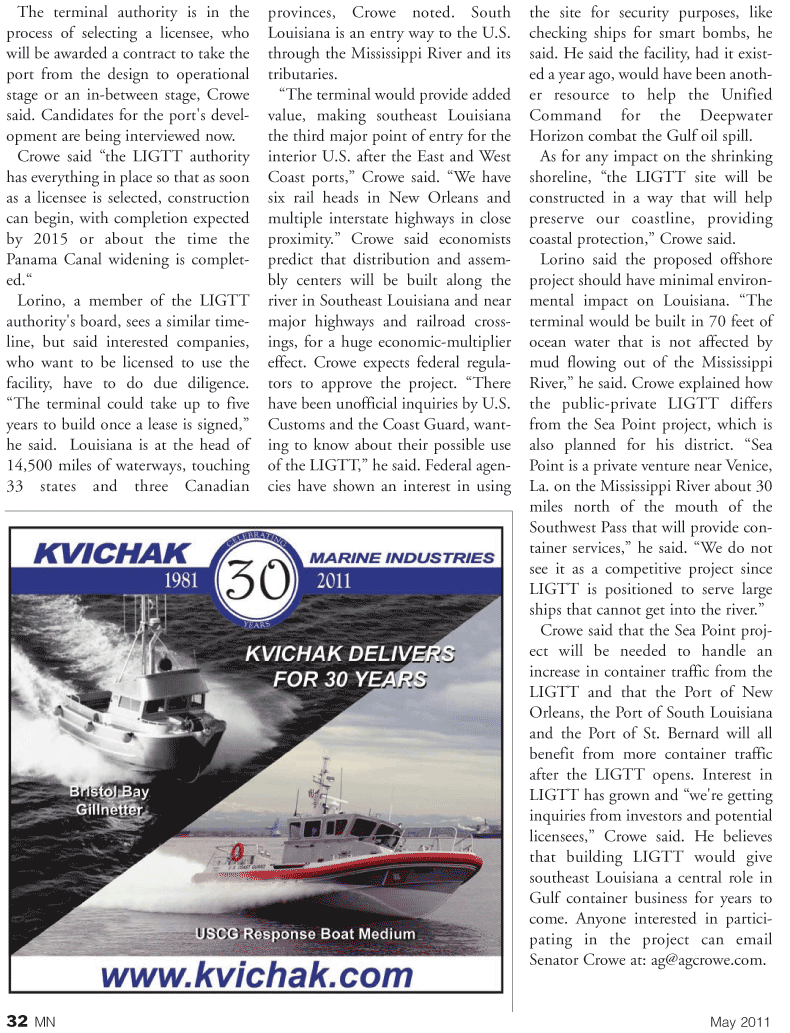
Page 32: of Marine News Magazine (May 2011)
Combat Craft Annual
Read this page in Pdf, Flash or Html5 edition of May 2011 Marine News Magazine
32 MN May 2011
The terminal authority is in the process of selecting a licensee, who will be awarded a contract to take the port from the design to operational stage or an in-between stage, Crowe said. Candidates for the port's devel- opment are being interviewed now.
Crowe said “the LIGTT authority has everything in place so that as soon as a licensee is selected, construction can begin, with completion expected by 2015 or about the time the
Panama Canal widening is complet- ed.“
Lorino, a member of the LIGTT authority's board, sees a similar time- line, but said interested companies, who want to be licensed to use the facility, have to do due diligence. “The terminal could take up to five years to build once a lease is signed,” he said. Louisiana is at the head of 14,500 miles of waterways, touching 33 states and three Canadian provinces, Crowe noted. South
Louisiana is an entry way to the U.S. through the Mississippi River and its tributaries. “The terminal would provide added value, making southeast Louisiana the third major point of entry for the interior U.S. after the East and West
Coast ports,” Crowe said. “We have six rail heads in New Orleans and multiple interstate highways in close proximity.” Crowe said economists predict that distribution and assem- bly centers will be built along the river in Southeast Louisiana and near major highways and railroad cross- ings, for a huge economic-multiplier effect. Crowe expects federal regula- tors to approve the project. “There have been unofficial inquiries by U.S.
Customs and the Coast Guard, want- ing to know about their possible use of the LIGTT,” he said. Federal agen- cies have shown an interest in using the site for security purposes, like checking ships for smart bombs, he said. He said the facility, had it exist- ed a year ago, would have been anoth- er resource to help the Unified
Command for the Deepwater
Horizon combat the Gulf oil spill.
As for any impact on the shrinking shoreline, “the LIGTT site will be constructed in a way that will help preserve our coastline, providing coastal protection,” Crowe said.
Lorino said the proposed offshore project should have minimal environ- mental impact on Louisiana. “The terminal would be built in 70 feet of ocean water that is not affected by mud flowing out of the Mississippi
River,” he said. Crowe explained how the public-private LIGTT differs from the Sea Point project, which is also planned for his district. “Sea
Point is a private venture near Venice,
La. on the Mississippi River about 30 miles north of the mouth of the
Southwest Pass that will provide con- tainer services,” he said. “We do not see it as a competitive project since
LIGTT is positioned to serve large ships that cannot get into the river.”
Crowe said that the Sea Point proj- ect will be needed to handle an increase in container traffic from the
LIGTT and that the Port of New
Orleans, the Port of South Louisiana and the Port of St. Bernard will all benefit from more container traffic after the LIGTT opens. Interest in
LIGTT has grown and “we're getting inquiries from investors and potential licensees,” Crowe said. He believes that building LIGTT would give southeast Louisiana a central role in
Gulf container business for years to come. Anyone interested in partici- pating in the project can email
Senator Crowe at: [email protected].

 31
31

 33
33
